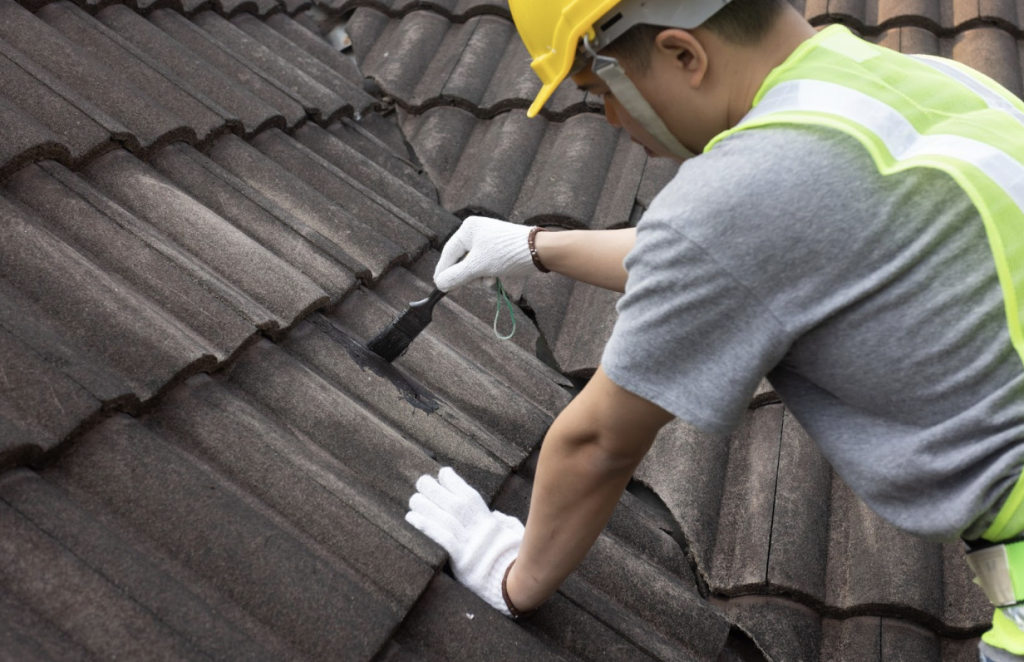A leaky roof is more than just a nuisance; it’s a serious threat to your home’s structural integrity and your family’s comfort. Left unchecked, even a small leak can escalate into a major problem, causing water damage, mold growth, and compromising your home’s insulation.
Prompt action on any signs of leakage, from sudden drips to subtle hints, is vital to avoid expensive future repairs. As you notice the signs, you may start worrying about how to stop roof from leaking.
In this article, we’ll examine common roof leak causes and offer practical solutions to address them. You’ll learn to identify leak sources, apply quick fixes, and implement long-term strategies for a watertight roof.
By understanding the anatomy of your roof and learning essential maintenance techniques, you’ll be better equipped to protect your home from the elements and maintain its value.

How to Stop Roof From Leaking
Roof leaks can cause big problems in your home if you don’t fix them quickly. Water damage can hurt your walls, ceilings, and belongings. It’s important to act fast when you spot a leak. So, adhere to the steps in the following to stop roof leaks and prevent more damage.
1. Identify the source of the leak
To fix a leak, first locate its origin. This can be challenging, as water often travels from the entry point. Begin by inspecting your attic in daylight. Search for wet spots or water stains on wood, which indicate water entry points. Focus on areas near pipes and vents. If safe, examine your roof externally.
Look for damaged or missing shingles, and inspect areas around chimneys and vents – common leak sites. If you can’t find the leak, you might need to do a water test. Have someone spray the roof with a hose while you watch inside for where water appears. Early detection helps prevent serious water damage, so it’s crucial to act quickly. If unsure, consult a professional to avoid worsening the problem.
2. Temporary fixes for immediate leak control
Once you find the leak, you need to stop it fast. There are quick fixes you can use until you get a full repair. Roofing tape is one option. It sticks well to most roof materials. Clean the area first, then apply the tape over the leak. Roof sealant is another choice for small holes. It comes in tubes or cans. Clean the leak area well, then apply the sealant and let it dry.
For bigger leaks, you can use a tarp. Get a thick, waterproof tarp and spread it over the leaking area. Make sure to secure it well with boards or weights.
These solutions can hold for days or weeks until you arrange for permanent repairs. However, remember they are only temporary and should be replaced with a lasting fix soon. Always monitor the area regularly to ensure the temporary fixes are holding up properly.
3. Replace damaged shingles or flashing
For a long-term fix, you may need to replace parts of your roof. Damaged shingles or flashing often cause leaks. To replace shingles, carefully remove the damaged ones, clean the area underneath, and install new shingles. Secure them with roofing nails, ensuring proper overlap to direct water flow.
Flashing, the metal that seals roof joints, also needs attention if damaged. Remove old flashing, clean the area, and install new flashing, sealing it with roofing cement to prevent water from seeping under the roof. Ensure the flashing is aligned properly to avoid gaps.
Regularly checking and maintaining flashing can prevent future leaks. Consider using high-quality flashing materials to increase durability and avoid frequent repairs.
4. Clear gutters and downspouts
Clogged gutters can cause roof leaks by forcing water to back up onto the roof. Clean your gutters regularly to avoid this issue. Use a scoop or your hands to remove leaves and debris, and then flush the gutters with water to ensure they’re clear. This should be done at least twice a year.
Check your downspouts as well, ensuring water flows freely. If necessary, use a plumber’s snake for deep clogs and ensure that downspouts direct water away from your home’s foundation.
Consider adding gutter guards to reduce the frequency of clogs and make maintenance easier over time. Installing extensions on downspouts can help keep water further from the foundation, preventing basement flooding or erosion.
5. Schedule a professional inspection
Sometimes, expert help is needed to fix a roof leak. A professional can identify hidden problems and perform repairs you may not be equipped to handle. Call a professional if you can’t locate the leak or if the damage seems extensive.
Professionals use specialized tools to find elusive leaks and can detect other roof issues. During an inspection, they will assess your entire roof, including shingles, flashing, and gutters, and may use tools like cameras or moisture meters to find hidden leaks. Afterward, they will provide a report detailing what needs to be fixed.
Scheduling annual roof inspections helps catch small issues early, saving time and money in the long run. A professional inspection can extend your roof’s lifespan and maintain its warranty.
How to Stop Roof Leaks From Inside
To stop roof leaks from inside, first, locate the leak by checking the attic for water stains or mold. Use chalk to mark the spot, then apply a temporary patch like roofing tar, plywood, or roofing cement to stop the water.
If immediate repair isn’t possible, divert the water using buckets, plastic sheeting, or a rubber raincoat. Once the leak is controlled, dry the area with fans, use a dehumidifier, and remove wet insulation.
For prevention, inspect the attic regularly, improve ventilation, and add insulation to avoid future leaks. Regular roof maintenance and quick action can prevent small issues from becoming major problems. Keep emergency roofing supplies on hand for unexpected leaks and always contact a professional for permanent roof repairs.

Conclusion
Addressing roof leaks promptly is crucial for protecting your home from water damage. By taking immediate action, homeowners can mitigate leaks and prevent further issues. From identifying the source to applying temporary fixes, each step is important in maintaining a sound roof.
Learning how to stop roof from leaking empowers homeowners to tackle this common problem effectively. Whether dealing with leaks from outside or managing them from inside, quick action and proper techniques are key.
Regular maintenance, including cleaning gutters and inspecting for damaged shingles or flashing, can prevent many leaks before they start. By staying vigilant and addressing issues promptly, you can ensure your roof continues to protect your home effectively for years to come.
